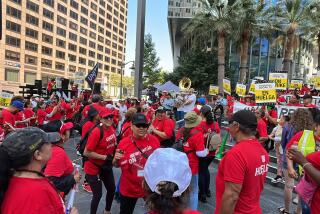Bubble Won’t Reinflate
- Share via
AMHERST, Mass. — Three years ago this month, the greatest stock market run-up in U.S. history came to an abrupt end. Since then, it has become abundantly clear that economic growth in the Clinton era was dependent on wildly inflated stock prices. It seems equally apparent that President Bush would love to reinflate that bubble. But despite efforts like the dividend-tax cuts that passed in May, he will almost certainly fail.
The bull market made life easy for politicians. When President Clinton left office in January 2001, the federal government had run surpluses for three straight years. Bush will have run three straight years of growing deficits by 2004.
Clinton needed the stock market boom because eliminating fiscal deficits brought cutbacks in government spending. But people working in the United States still needed customers to buy their products. The declines in government spending under Clinton therefore had to be matched by increases in spending elsewhere.
This is how the stock market bubble became the bedrock of Clintonomics. Spending by households and corporations grew rapidly during the 1990s, but this was tied closely to the bubble. By 2000, households were spending a remarkable 99 cents of every dollar of disposable income, leaving only one cent on the dollar for savings. But almost all of this increased spending came from the richest 20% of households. They spent $1.04 for every dollar of income, and covered the difference by borrowing on their burgeoning paper wealth.
Corporations also borrowed heavily against their rising stock prices to finance what turned out to be excessive investment in machines and equipment. As of June, U.S. industrial firms were still saddled with excess capacity, making use of only 74% of their available production equipment. This is down from an average of 82% between 1967 and 1992.
Clinton handed over to Bush a precarious financial pyramid, even after allowing for his federal government surpluses. But this isn’t to say that Bush is now blameless for the country’s economic difficulties. His determination to deliver tax cuts for the rich -- and in particular his most recent victory in lowering taxes on dividends, from a maximum of 38.6% to a flat 15% -- is likely to lead the country into some of the same kinds of financial traps that emerged under Clintonomics.
Nothing Bush can do is likely to push stock prices back up to anything close to the bubble-era stratosphere. This becomes clear from considering the historical pattern of the earnings-to-stock-price relationship in the U.S. market. The average firm in the Standard & Poor’s 500 index today earns about 3.6% relative to the price of its shares. This contrasts with the 109-year period between 1880 and 1989, during which the average S&P; firm earned nearly 7% relative to the price investors paid to buy shares. From this perspective, the price of the average S&P; stock still needs to fall almost another 50% relative to earnings, even three years after the bubble burst.
True, the Bush dividend-tax cut changes things somewhat, since the average wealthy shareholder now gets to keep 85 cents rather than 65 cents of every dollar a firm pays out in dividends. This means that a dollar of dividends is now worth up to 30% more than it was before the Bush tax cut. But this 30% gain in the after-tax value of dividends at best only partially counteracts the current market overvaluation of nearly 50%.
Many market analysts claimed during the bubble years that historic stock-price-to-earnings relationships no longer applied. Let’s assume for the moment that they were right and that Bush’s tax cuts could generate a renewed stock market boom. Even then, because Bush has taken no steps to avoid the excesses of debt and industrial capacity that built during the Clinton years, the likelihood is that a renewed stock market boom would not produce stable and sustainable growth.
It’s impossible, of course, to know the future. But what we’re likely to see emerge from the current policies is a sputtering recovery followed by an even more vulnerable financial system than the one we faced when the Clinton bubble burst three years ago.
More to Read
Inside the business of entertainment
The Wide Shot brings you news, analysis and insights on everything from streaming wars to production — and what it all means for the future.
You may occasionally receive promotional content from the Los Angeles Times.









